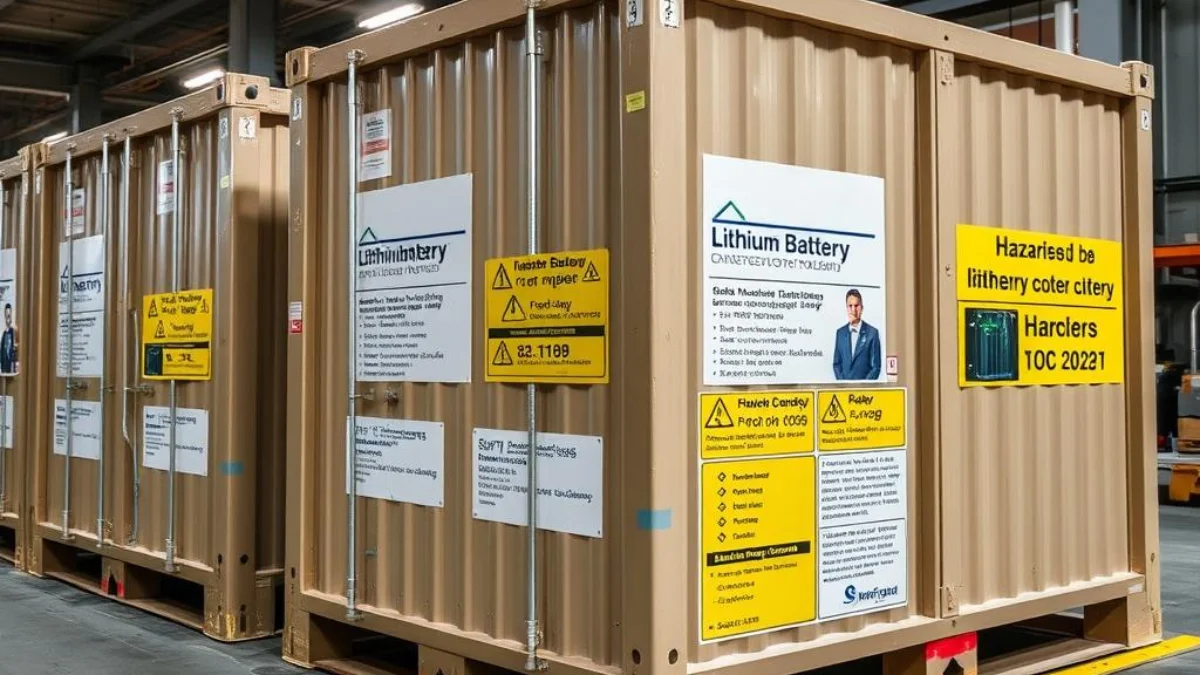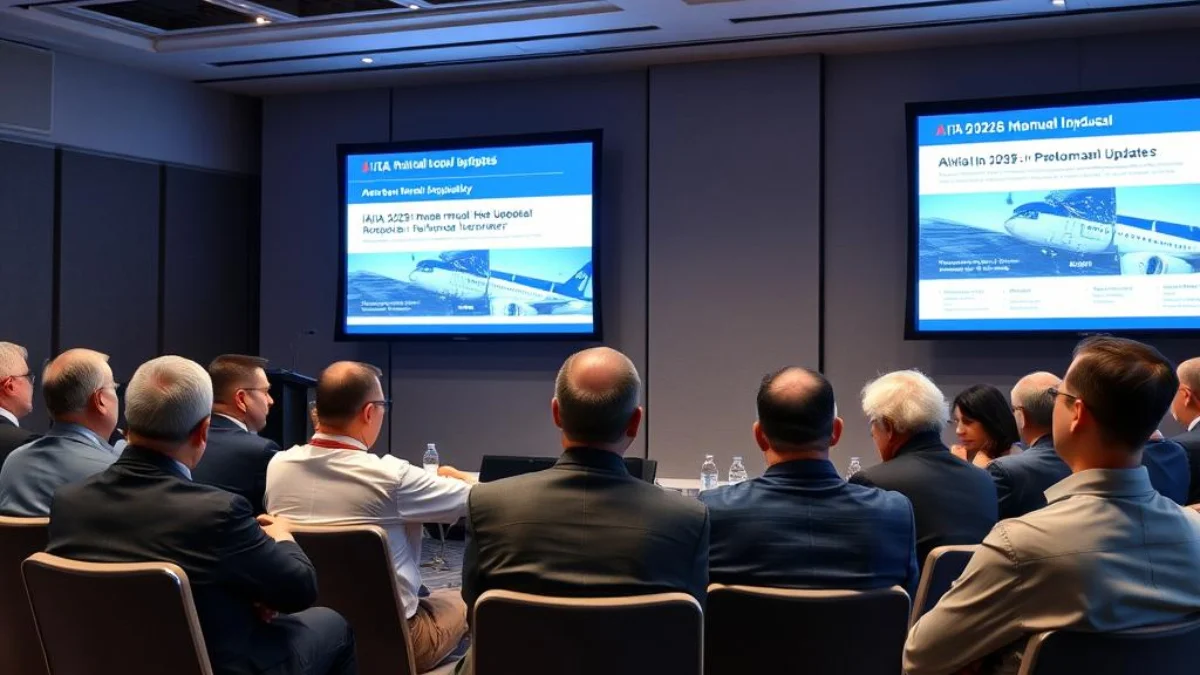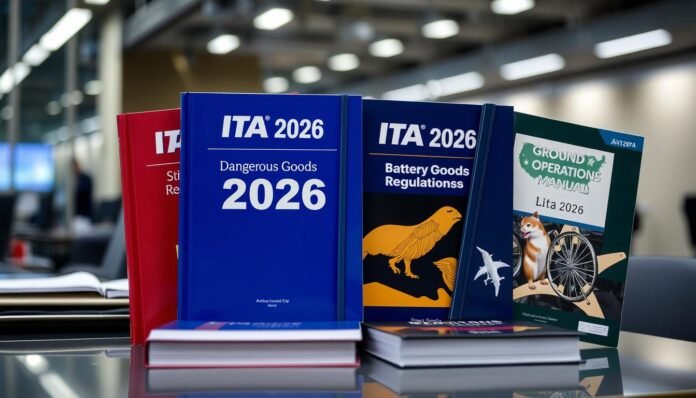Comprehensive analysis of IATA 2026 Cargo and Ground Operations Manuals Update with key changes to dangerous goods, battery shipping, animal transport regulations, and implementation guidance.
The International Air Transport Association (IATA) has released the 2026 editions of its cornerstone manuals for cargo and ground operations on October 27, 2025. These updates incorporate nearly 100 significant changes to align with evolving global aviation industry standards. The revisions impact key operational areas, including dangerous goods handling, battery shipping protocols, animal welfare standards, and ground operations procedures.
For aviation professionals responsible for regulatory compliance, these changes represent significant operational adjustments that will require careful implementation planning. This comprehensive analysis examines the critical updates, their industry impact, and provides actionable guidance for seamless adoption of the new standards.
The 2026 editions of IATA’s key operational manuals introduce significant regulatory changes
IATA 2026 Cargo and Ground Operations Manuals Update- Scope and Significance of the Updates
The 2026 IATA manual updates represent one of the most comprehensive revisions in recent years, with modifications spanning four critical operational domains. These changes respond directly to emerging industry challenges, technological advancements, and evolving safety standards in global air transport.
Key Manuals Updated:
- Dangerous Goods Regulations (DGR)
- Battery Shipping Regulations (BSR)
- Live Animals Regulations (LAR)
- IATA Ground Operations Manual (IGOM)
Primary Focus Areas:
- Enhanced lithium battery safety protocols
- Standardized animal welfare requirements
- Streamlined ground handling procedures
- Digital compliance tools integration

Background & Context: Why These Updates Matter
The 2026 manual revisions address several critical industry developments that have emerged since the previous edition. Understanding these contextual factors helps explain the rationale behind specific regulatory changes and their operational implications.
Lithium Battery Concerns
A 25% year-on-year increase in lithium battery air transport, combined with several incidents involving overheating power banks, has necessitated stricter regulations around battery shipments.
Animal Transport Growth
With over 200,000 non-domestic animal shipments recorded in 2024, enhanced welfare standards have become essential to ensure safe and humane transport conditions.
Operational Efficiency
Evolving passenger needs and baggage handling technologies have driven updates to ground operations procedures to improve efficiency while maintaining safety standards.
“Global standards have made flying safe and reliable. This year’s IATA manuals updates reflect advancements in technology, digitalization, regulation, and customer needs that are critical for safer, more efficient, and increasingly sustainable operations.”
Key Changes: What’s New in the 2026 Manuals
Dangerous Goods Regulations (DGR) and Battery Shipping Regulations (BSR)
The most substantial changes in the 2026 manuals relate to battery shipping regulations, reflecting the industry’s growing concern about lithium battery safety. These updates respond directly to the emergence of new battery technologies and recent safety incidents.

DGR Key Updates:
- Formalized shipping names for hybrid-powered vehicles
- Updated recommendations for passenger power bank usage
- New country variations for Thailand, France, and UK
- Standardized text for 290 existing operator variations
- Enhanced safety data sheet requirements
- New Appendix H outlining anticipated 2027 changes
BSR Key Updates:
- Stricter charge limits for lithium-ion batteries packed with equipment
- Comprehensive shipper compliance checklist
- Expanded list of Designated Postal Operators authorized to accept lithium battery shipments
- Improved battery classification tool now includes sodium-ion batteries
Live Animals Regulations (LAR)
The 2026 LAR updates focus on enhancing animal welfare standards during air transport. With significant growth in animal shipments, these changes aim to ensure consistent care and handling practices across the industry.

- Comprehensive guidelines for animal attendants with standardized Competency-Based Training Assessment recommendations
- Brazil’s official adoption of LAR standards in 2025 now reflected in the manual
- Enhanced material and ventilation specifications for animal containers
- Species-specific guidelines for poultry, pangolins, hooded raptors, and birds of prey
- Introduction of the LAR Verify online portal for digital access and automated compliance solutions
IATA Ground Operations Manual (IGOM)
The 2026 IGOM revisions prioritize operational efficiency and passenger handling improvements, with particular attention to special assistance requirements and baggage tracking standards.

- Updated protocols for unaccompanied minors, unruly passengers, and those requiring medical assistance
- Baggage tracking guidelines aligned with IATA Resolution 753
- Revised procedures for potable water preparation, collection, and transportation
- Streamlined aircraft turnaround procedures to improve operational efficiency
Stakeholders & Affected Parties
The 2026 IATA manual updates will impact numerous entities across the aviation ecosystem. Understanding which stakeholders are affected and how they must adapt is crucial for effective implementation planning.

Effective implementation requires coordination across multiple aviation stakeholders.
| Stakeholder | Primary Impact Areas | Required Actions |
| Airlines | All manual updates, particularly operational procedures | Update training programs, revise operational manuals, and implement new digital tools |
| Cargo Operators | DGR, BSR, and digital compliance tools | Revise acceptance procedures, update staff training, and implement new labeling requirements. |
| Ground Handling Companies | IGOM and special assistance procedures | Update standard operating procedures, train staff on new requirements |
| Animal Transporters | LAR and container specifications | Upgrade containers, implement new training for attendants |
| Regulatory Bodies | Alignment with national regulations | Review and potentially update national standards to align with IATA changes |
Industry & Expert Reactions
Initial responses to the 2026 IATA manual updates have mainly been positive, with industry experts highlighting the focus on safety enhancements and operational efficiency. However, some stakeholders have expressed concerns about implementation timelines and resource requirements.

Safety Advocates
Safety organizations have welcomed the enhanced battery shipping regulations, citing the critical need to address risks associated with the growing volume of lithium battery transport.
Operational Leaders
Ground handling executives appreciate the streamlined procedures but note that implementation will require significant staff training and process adjustments.
Animal Welfare Groups
Animal protection organizations have praised the strengthened LAR standards while encouraging even more comprehensive welfare provisions in future updates.
“The 2026 updates represent a significant step forward in addressing emerging safety challenges, particularly regarding lithium battery transport. The industry must now focus on effective implementation to realize these safety benefits.”
Implementation Challenges & Solutions
While the 2026 IATA manual updates enhance safety and operational standards, they also present implementation challenges for affected organizations. Understanding these challenges and developing practical solutions is essential for successful adoption.
Implementation Challenges
- Short timeline for operational adjustments
- Staff training requirements across multiple departments
- Technology integration for new digital tools
- Cost implications for container upgrades and process changes
- Coordination across international operations with varying regulatory frameworks
Recommended Solutions
- Develop phased implementation plans with clear milestones
- Create comprehensive training modules for specific operational areas
- Establish cross-functional implementation teams
- Leverage IATA’s digital tools for compliance verification
- Conduct a gap analysis between current operations and new requirements
Best Practices for Successful Adoption
Organizations that successfully implement regulatory changes typically follow established best practices that ensure comprehensive adoption while minimizing operational disruption. The following approaches can help aviation stakeholders effectively integrate the 2026 IATA manual updates.
1. Gap Analysis
Conduct a thorough assessment comparing current operations against new requirements to identify specific areas requiring modification—document findings in a structured format that can guide implementation priorities.
2. Phased Implementation
Develop a staged implementation approach, prioritizing critical safety requirements while allowing sufficient time for more complex operational changes. Create clear timelines with specific milestones.
3. Staff Training
Design role-specific training modules that focus on relevant changes for each operational area. Utilize both theoretical and practical training methods to ensure comprehensive understanding.
4. Technology Integration
Leverage IATA’s new digital tools to streamline compliance verification. Ensure IT systems are updated to accommodate new requirements and data fields for proper documentation.
5. Supplier Engagement
Communicate new requirements to suppliers, particularly for animal containers and battery packaging. Establish verification processes to ensure supplied materials meet updated standards.
6. Compliance Monitoring
Implement robust monitoring systems to track compliance with new requirements. Develop key performance indicators to measure implementation progress and effectiveness.
Future Outlook: Beyond 2026

The 2026 IATA manual updates represent an essential step in the ongoing evolution of aviation safety and operational standards. Understanding the trajectory of future developments can help organizations adopt a more strategic approach to regulatory compliance.
Anticipated Industry Developments
Technological Advancements
- Increased automation in dangerous goods verification
- Enhanced tracking systems for live animal shipments
- AI-assisted compliance verification tools
- Blockchain for secure documentation and verification
Regulatory Evolution
- Further refinement of battery shipping requirements
- More comprehensive animal welfare standards
- Integration with sustainability initiatives
- Harmonization with emerging national regulations
The inclusion of Appendix H in the 2026 DGR, which outlines anticipated changes for 2027, signals IATA’s commitment to providing advance notice of regulatory developments. This forward-looking approach allows organizations to adopt a more proactive stance toward compliance planning.
The 2026 IATA Cargo and Ground Operations Manuals Update represents a significant evolution in aviation safety and operational standards. With nearly 100 major changes spanning dangerous goods regulations, battery shipping protocols, animal welfare standards, and ground operations procedures, the impact on industry stakeholders is substantial.
Successful implementation will require careful planning, comprehensive staff training, and strategic resource allocation. Organizations that adopt a systematic approach to compliance will not only ensure regulatory compliance but may also realize operational efficiencies through improved processes and the integration of digital tools.
As the aviation industry continues to evolve, staying informed about regulatory developments remains essential for operational excellence and safety enhancement. The 2026 updates demonstrate IATA’s ongoing commitment to addressing emerging challenges while providing the industry with clear guidance for implementation.

